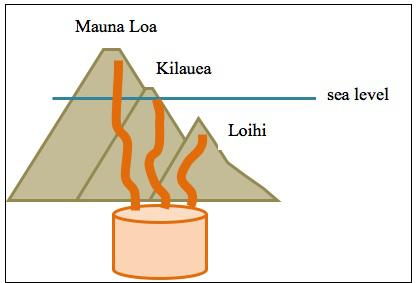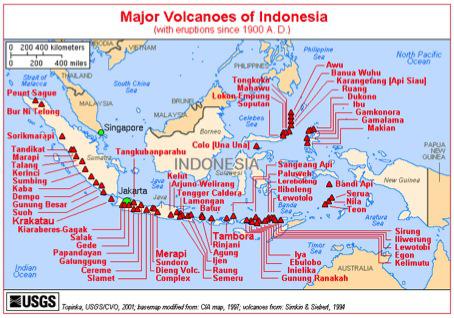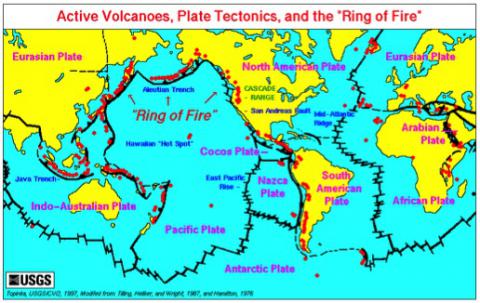Hawaii and Indonesia – Activity and Information for Students
Learning Objectives
Make scientific interpretations from authentic data (a plot of volcano ages and locations)
Evaluate the precision of scientific data (optional)
Describe and contrast the formation of Hawaiian and Indonesian volcanoes
Describe the relationship between plate tectonics, mantle plumes, and volcano locations
Standards Addressed
Within standard area 3.3.A Earth Structure, Processes and Cycles, this activity and its elements are appropriate for grade bands 6-8 and 9-12 as part of "Earth Features and the Processes that Change It". They are also appropriate for multiple Unifying Themes across the same grade bands. The activity also addresses mathematical concepts of graphing and slope.
Supplies/Materials/Articles Needed
Maps and figures are provided, but students will need graph paper, pencils, rulers and calculators if they generate the plots themselves (strongly recommended). Notes for teachers are available here: http://www.paesta.psu.edu/classroom/teaching-about-volcanoes-plate-tecto....
Preparation Time Needed
There is no substantial preparation needed to use this activity in class. The teacher will need to print out in advance any images that the students would view in hard copy. As with any activity, we strongly recommend that the teacher work through the exercise in advance (and contact the author if you have questions).
Class Time Required
This activity can be accomplished in two or three class periods, but the graphing can be assigned for homework. If a longer time period is desired, the activity can be implemented over a period of more than a week by encouraging students to prepare reports based on the web sites indicated.
Activity Description
Part I: Overarching Question: What is the relationship between the motion of the Pacific plate and that of the Hawaiian hot spot over the last 70 million years?
See also: Teaching About Volcanoes in a Plate Tectonic Context
Begin by examining a map of Hawaii that shows the entire volcanic chain including the Emperor Seamounts (http://pubs.usgs.gov/gip/dynamic/Hawaiian.html is one nice example).
- After reading the information below, plot the data in Table 1 using Excel to see the relationship between volcano age (on the x-axis) and distance from Kilauea (on the y-axis).
- On the basis of your graph, determine the relative motion of the hot spot and the Pacific plate. In order to determine that relationship answer the following questions:
- What is the slope of the line (be sure to include units)?
- What does the slope represent?
- What is the slope in mm/yr?
- How does this rate compare to the spreading rate of the Mid-Atlantic Ridge (about 1 cm/yr)?
- When did the orientation of the Hawaiian-Emperor chain change?
- How is this change manifest on your graph of distance versus age?
It is important to note that the time over which individual volcanoes on the islands remain active is long (hundreds of thousands of years) so that significant overlap in ages occur on neighboring islands. For example, although Haleakala volcano on Maui is far from the presently erupting Kilauea, Haleakala last erupted only about 200 years ago. Currently there are three Hawaiian volcanoes that we can easily classify as active: Kilauea, actively erupting since 1983; Mauna Loa, which last erupted in 1984; and Loihi seamount, which erupted in 1996. All three of these volcanoes share the Hawaiian hot spot, but retain unique volcanic histories and compositions. The likely dormant volcanoes are Hualalai, which last erupted in 1801, Haleakala, which last erupted in ~1790 and Mauna Kea, which last erupted about 4,000 years ago.

Schematic cross-section of Hawaii showing how three active volcanoes tap the top of the Hawaiian hot spot or mantle plume
Table 1: Ages and Locations of Volcanoes in the Hawai’i-Emperor Chain Volcano Name Distance from Kilauea along trend of chain (km) Best K-Ar age (Ma) Uncertainty (Ma)
| Volcano Name | Distance from Kilauea along trend of chain (km) | Best K-Ar age (Ma) | Uncertainty (Ma) |
| Kilauea | 0 | 0-0.4 | |
| Mauna Kea | 54 | 0.38 | 0.05 |
| Kohala | 100 | 0.43 | 0.02 |
| Haleakala | 182 | 0.04 | 0.04 |
| Kahoolawe | 185 | 1.03 | 0.18 |
| West Maui | 221 | 1.32 | 0.04 |
| Lanai | 226 | 1.28 | 0.04 |
| East Molokai | 256 | 1.76 | 0.04 |
| West Molokai | 280 | 0.06 | 0.06 |
| Koolau | 339 | 0.1 | 0.1 |
| Waianae | 374 | 3.7 | 0.1 |
| Kauai | 519 | 5.1 | 0.2 |
| Niihau | 565 | 4.89 | 0.11 |
| Kaula | 600 | 4 | 0.2 |
| Nihoa | 780 | 7.2 | 0.3 |
| Unnamed | 913 | 9.2 | 0.8 |
| 930 | 9.6 | 0.8 | |
| Necker | 1,058 | 10.3 | 0.4 |
| La Perouse Pinnacles | 1,209 | 12 | 0.4 |
| Brooks Bank | 1,256 | 13 | 0.6 |
| 1,330 | 13 | 0.6 | |
| Gardner Pinnacles | 1,435 | 12.3 | 1 |
| 1,460 | 12.3 | 1 | |
| Laysan | 1,818 | 19.9 | 0.3 |
| Northampton Bank | 1,841 | 26.6 | 2.7 |
| Pearl and Hermes Reef | 2,281 | 20.6 | 2.7 |
| Midway | 2,432 | 27.7 | 0.6 |
| Unnamed | 2,600 | 28 | 0.4 |
| Unnamed | 2,825 | 27.4 | 0.5 |
| Colohan | 3,128 | 38.6 | 0.3 |
| Abbott | 3,280 | 38.7 | 0.9 |
| Daikakuji | 3,493 | 42.4 | 2.3 |
| Yuryaku | 3,520 | 43.4 | 1.6 |
| Kimmei | 3,668 | 39.9 | 1.2 |
| Koko (southern) | 3,758 | 48.1 | 0.8 |
| Ojin | 4,102 | 55.2 | 0.7 |
| Jingu | 4,175 | 55.4 | 0.9 |
| Nintoku | 4,452 | 56.2 | 0.6 |
| Suiko (southern) | 4,794 | 59.6 | 0.6 |
| Suiko (central) | 4,860 | 64.7 | 1.1 |
Part II: Overarching Question: How does the Hawaiian volcanic system compare to that of Indonesia?
Go to the following websites and search for information about the volcanoes in Indonesia
- http://www.volcano.si.edu/region.cfm?rn=6
- http://www.vulkaner.no/v/volcan/sjordi/ebcindo.html
- http://pubs.usgs.gov/gip/volc/types.html
- http://www.cotf.edu/ete/modules/volcanoes/vtypesvolcan1.html
Examine a geological map that shows the location of the major Indonesian volcanoes (below) and determine the age of the volcanoes.
- Starting from the westernmost Indonesian volcano, plot a graph that shows distance vs. eruptive age as you did for Hawaii
- Compare this graph to the one you made for Hawaii. Answer the following questions:
- How are they alike?
- How are they different?
- Compare the size and shape of the active volcanoes of Hawaii and Indonesia
- What information did you find about the formation of the volcanoes in Indonesia?
- How does the formation of volcanoes in Indonesia differ from the formation of volcanoes in Hawaii?
- What is the significance for humans of the volcanic formation style?
Part III: Overarching Questions: What is the relationship between volcanic eruptive style, volcanic age, volcanic formation, and plate tectonics? What conclusions can you make from these relationships?
- Describe and contrast the formation of Hawaiian and Indonesian volcanoes.
- What is the importance in being able to contrast volcanic formation?
Part IV: Conclusion
Overarching Questions: How does learning this information impact your life? Why it is important to teach these concepts?
- After concluding these exercises; why it is important to teach these concepts?
- How can you implement this activity in your classroom?
- What is the benefit of learning this science content?
- How can we nurture students’ interest in this field?
Prepared by: Tanya Furman & Molly Witter, Department of Geosciences, Pennsylvania State University
2011



